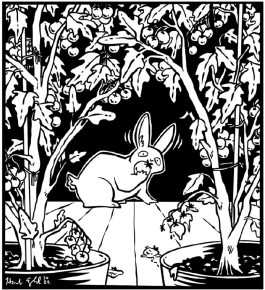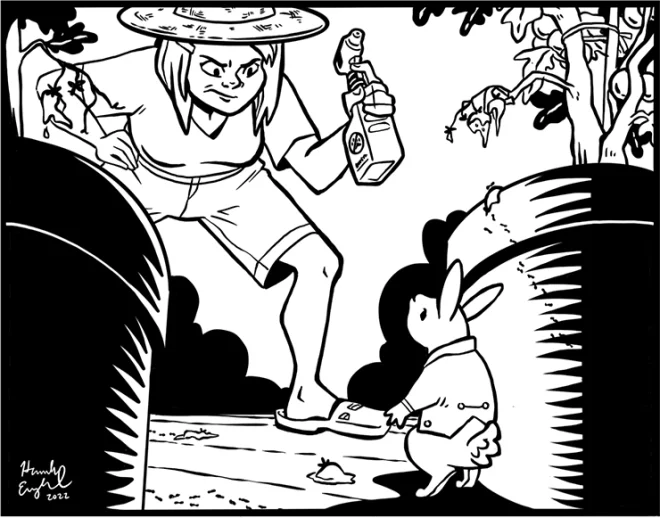I was a bunny-loving little girl. Every night—without fail—my mother would read me the Runaway Bunny or Beatrix Potter’s The Tale of Peter Rabbit. Since I had an older sister who was allergic to furry animals, the only cuddly creatures I could enjoy were in books. So I grew up reading stories about bunnies. I especially loved Peter Rabbit’s adventures in Mr. McGregor’s garden. I don’t know if it was the forbidden nature of the challenge—Peter’s mother always told him not to go there—or the joy Peter felt while eating the vegetables he snitched, but the scenes in Mr. McGregor’s garden were my favorite part of these stories. The confrontations were so dramatic. The prospect of being baked into a pie was extra frightening because Peter’s family knew someone who had been interred in a pastry. And Mr. McGregor was a crotchety old man. He had more than enough delicious food for himself, but he was too mean and selfish to share it with the sweet, jacket-wearing rabbits that lived in his neighborhood.

Peter Rabbit was clever, though. I remember holding my breath every time Mother read the part where Peter hid in a watering can. When the coast was clear, Peter bounded under the fence—tearing all the clothes off his back—and bounded home with his bounty. What a narrow escape!
It was clear to me: the bunny, not the gardener, was the hero.
Many years have passed since I’ve read The Tale of Peter Rabbit. Somehow in that time, I have become a gardener myself. Last year was my first try at growing a vegetable garden—in pots and felted containers on my patio. Though my cherry tomato plants were top-heavy and often under-watered, they eventually began to bear fruit. I was so proud! Seeds that I’d nurtured for months had grown into amazing plants that now made fruits and seeds themselves.
Then I popped one of the tomatoes into my mouth—and my life changed. They tasted So Good! And they kept ripening for weeks. I could harvest some nearly every day! The patio, with its stone wall, warm sun, and mouth-watering cherry tomatoes, became my favorite outdoor spot.
I spent enough time outside to notice something new. My cat had died not long ago, and my backyard—previously kept void of animal life by Ernie—was now full of small creatures. One chipmunk in particular was so brazen it seemed like he was daring Ernie to come back from the grave and catch him.
Chippy (yes, I named him) was adorable: lively, full of spunk, and exceptionally plump-cheeked. I instantly fell in love with him. He used our patio as his own little highway, a safe haven where he could weave amongst the pots and not be seen by our new fox and local red-tailed hawk. Chippy’d sit atop a broken statue on the patio and relish the small seeds he had foraged from around the yard. Occasionally I would leave nuts on top of the statue to make life a little easier for him. It was a lovely arrangement for both of us.
Until I made a big mistake.

One day while harvesting tomatoes, I plucked one that was under-ripe and misshapen. I threw it into a nearby juniper bush, thinking it would rot or the birds would peck at it. Not ten minutes later, I spotted cute little Chippy running from the bush—and holding the small green tomato in his mouth. I watched him carry the little-to-me, giant-to-him fruit across the yard to the curb of my driveway. Then he set it down and, turning it over and over with his tiny hands, gobbled it up. I smiled. He looked so happy.
The next day, almost a dozen of my ripest cherry tomatoes were gone. Shreds of chewed fruit skin lay on the ground near the plants. Chippy had figured out that the tomatoes on the patio were one, scrumptious, and two, his for the taking. And who had shown him how tasty these rodent-sized treats were? Me!
Suddenly, Chippy was ravaging my potted tomatoes. No fruit was safe! I tried wrapping my plants in netting. No good: Chippy could squeeze between the netting and the stone wall the plants leaned against. I covered individual clusters of tomatoes with mesh bags and, the next morning, discovered ripped sacks on the plants and more shredded tomato skins on the ground. I attempted chemical warfare by sprinkling cinnamon, hot peppers, and chili powder over the sacks and fruits. This worked well—until it rained.
I searched the internet and discovered sonic deterrents, motion-activated devices that use irritating high-pitched sounds to drive away animals. Maybe, I thought. I investigated the idea of catching Chippy in a live animal trap and releasing him into a distant forest. Hmmm, I pondered. I read about squirting pests with diluted vinegar to discourage garden visits. I’ll try that, I decided.
Early the next morning, I was tiptoeing quietly around the side of the house, hoping to catch Chippy in the act—and saw my reflection in the window, There I was, a wide gardening-hat brim hiding my eyes, a vinegar-filled water pistol in each hand, and a scowl on my face. I stopped and stared. I had become the villain in all my childhood stories! I was Mr. McGregor.
Well, so what? Indeed, I now sympathized with him. His garden was not full of tasty vegetables by accident. It was due to months of hard labor, weeding, watering, and nurturing plants every step of the way from seed to fruit. Gardeners toil day after day—hands dirty, backs aching, and knees sore. To have the rewards for their effort then be ruined by a pest like some chipmunk? Bah, humbug!
I will always love Peter Rabbit, but now I agree with his moth-er. I say to Peter and all other cute, charming woodland creatures, “Stay out of Mr. McGregor’s garden.”
And mine. ❖



 Previous
Previous

